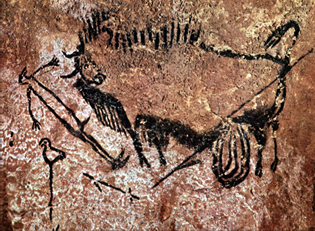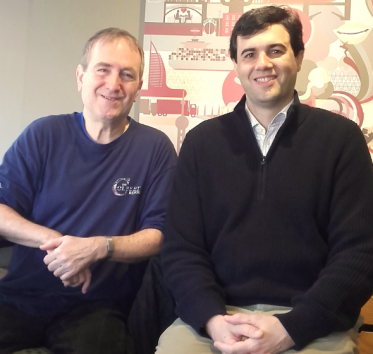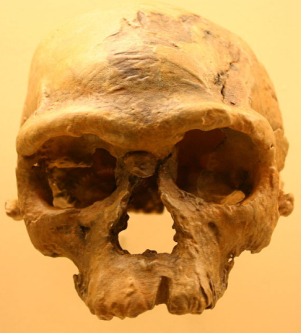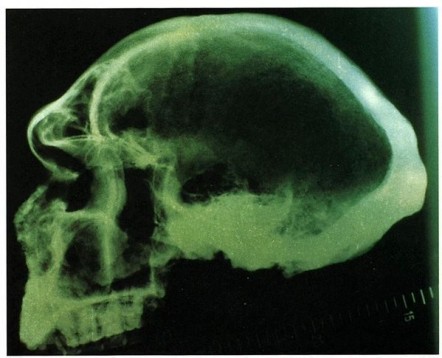In this interview for Nutcracker Man, Chris Stringer addresses some key recent discussions in the human evolution field, such as:
- The origin of the anatomically modern humans. The frontier between ‘archaic’ and ‘modern’ Homo sapiens.
- Reassessment of the Homo heidelbergensis species.
- Early and late dispersals of modern humans outside Africa.
- Behavioural modernity vs. Anatomical modernity.
Finally, he talks about a new book he is working on.
Chris Stringer is one of the most important researchers in the field of human evolution. He is Research Leader in Human Origins at the Natural History Museum and previously director of the Ancient Human Occupation of Britain project. His work is searchable on the Museum’s website and you can follow him on twitter.
1. The origin of the so-called anatomically modern humans is not so clear now in the post-Neanderthal genome era. In 2016, you argued a new paradigm by setting the origin of our species Homo sapiens back to 500 K years ago rather than 200 K. What is the rationale for that? What is for you an ‘archaic’ Homo sapiens? And what is the frontier between ‘archaic’ and ‘modern’ Homo sapiens?
From my point of view, the terms anatomically modern and archaic are difficult to define but we need some clarity in using them. For me, the pattern of anatomically modern humans is really the pattern in the skeleton we have today, particularly a high and rounded skull, a small face under the braincase, the chin on the lower jaw, a lighter-built skeleton with a narrow pelvis… These are the sort of things which typify modern humans today. So when we look in Africa for when that pattern can be found, I think we can take it back to between 150 K and 200 K years at least for most of that pattern, with the material from Herto 1 and 2 and Omo 1. But once when we get further than that, at the moment we count less specimens that show the majority of the features, we see some of them only, for example the material from Florisbad, Eliye Springs, maybe Ngaloba -not well dated- and Jebel Irhoud -very important, not well dated at the moment. Once we get beyond 200 K, there are specimens in the Homo sapiens line, but I think they do not yet show most of the patterns we found today. So that is the expectation that it will go beyond 200 K years.
Then, if we look at the other side of the story, of course we have a common ancestor with our closest relatives, the Neanderthals and now we have to add the Denisovans, and when that was that ancestor around? For a long time I supported the view that the ancestor probably lived maybe 400 K years ago. We can support that from mitochondrial DNA that seems to suggest a common ancestor around 400 K years, and also if we look at the fossil record there are signs of Neanderthal features maybe in Swanscombe at 400 K, but in my previous view the majority of the features came after that time.
Then, the Sima de los Huesos material is very interesting and important, because it is a large sample that clearly shows many Neanderthal features, particularly in the teeth and in various aspects of the skeleton. And now we have genomic data that shows it is already well on the Neanderthal line. So for me that is a sign that the common ancestor must go back probably some way beyond the date of the Sima materials, which has become quite clear to be probably at least 400 K years old.
We also have to consider the latest genetic data which actually puts the common ancestor maybe somewhere to 600 K or 700 K years, some people may say even further back. So this raises the whole issue: if we have a common ancestor 600 or 700 K, there must be quite a long record of Homo sapiens in Africa before 200 and even 400K years.
We can even consider in the Middle Pleistocene fragmentary fossils such as the Ndutu skull, the Salé skull or the Thomas Quarry material. Maybe some of these specimens are actually even early Homo sapiens rather than -what I have called them- Homo heidelbergensis.
So I think there is growing evidence that that divergence goes back a long way and we need a term for Homo sapiens in Africa before you have the majority of modern human features. So that is where I use the term archaic Homo sapiens.
And I think to use that term outside of Africa is meaningless. Sometimes the Dali material from China is called archaic Homo sapiens. It is meaningless because it just really means that they have a slightly bigger brain than erectus, but other features we find in Dali, I do not think there are the specific features that we find in the African specimens.
So I am against the use of archaic Homo sapiens anywhere except in Africa, for the early part of our lineage. And the complexity of the pattern shows that the archaic pattern might have actually gone on for a long time in Africa. When you look at Omo Kibish, we have the Omo 2 skull, around the same date as far as we can tell as the Omo 1 skull, and yet showing a pattern which for me is not an anatomically modern pattern. So again this may be a sign that even in Africa you’ve got a lot of complexity: different specimens are showing different combinations of these modern human and archaic features. So it is a complicated pattern, but I think we can say that at least 200 K we begin we see clear signs of that modern human pattern in Africa.
2. In the last few years, you have been very explicit in defending the reassessment of the Homo heidelbergensis species. What do you think is needed to get a consensus for relocating this species and reclassifying the hominin fossils traditionally assigned to it?
A very difficult question. My concept of heidelbergensis really began with the recognition by data from my PhD that an African specimen from Broken Hill resembles in terms of overall cranial shape this European specimen from Greece, Petralona. So that for me was the foundation of the idea that there was a species in the Middle Pleistocene that was in Europe and Africa, probably in Asia too. I also thought that erectus did not represent a good last common ancestor for us and Neanderthals. In my view the ancestor would have had some features such as a larger brain, a high temporal bone, a more gracile tympanic, a face that is less projecting in total, given those common features of us and the Neanderthals. So this is how the concept of heidelbergensis grew, and of course the tricky thing is what to call that common ancestor that I argued was there in the Middle Pleistocene.
In the 1970s and 1980s I was influenced by the dating of Petralona as being a contemporary of Mauer, and therefore to begin with I put them together really on chronological grounds – of course you could not do it morphologically, because Petralona does not have a jaw bone neither does Broken Hill, and the Mauer mandible does not have a skull. So this was one of the fundamental problems. Maybe in retrospect I should have been more cautious in putting the Mauer mandible into that mix.
To solve the problems we need to find skulls with mandibles in that time period. We need to find the skull that goes with Mauer, and we need to find the mandibles that go with Broken Hill and Petralona. And the name is problematic at the moment, but one could equally argue now that it could be Homo rhodesiensis, the name originally given to Broken Hill. And so I think this is one of the tricky issues, that the Mauer mandible is very idiosyncratic, it has some very distinctive features.
So we definitely need more mandibular and dental material from Africa that really can help us say what was that pattern variation in the things that I called heidelbergensis in Africa. In the long term I am not too bothered whether it is called heidelbergensis or rhodesiensis, but I do think there was a wide spread species in the Middle Pleistocene that fits that morphology, that we see in Bodo, in Petralona, in Broken Hill, and in Arago probably.
Whether that is the common ancestor of us and Neanderthals, is now a much more open question, because when you look at the deep divergence dates between us and Neanderthals, that divergence could be beyond that any of the known heidelbergensis fossils. On its own, though, that wouldn’t exclude heidelbergensis as being the common ancestor, or rhodesiensis.
But when you look at the facial morphology, I think now there is better evidence that the modern-looking facial morphology that we have -this retracting face with delicate cheekbones- is there in the antecessor fossils, not just in the child but there are now some other specimens including adult specimens that seem to show that facial morphology. And the growth pattern -also of that antecessor child- seems to be quite like that of Homo sapiens in the face. So that makes me more cautious now and we have to consider the idea that the sapiens face -rather than a late development in the last 250 K years- may be primitive and it goes back deep into the Middle Pleistocene. In which case, the big skulls of heidelbergensis -that do not show that modern human morphology in the face- may be not on the modern human lineage but may be part of a clade which includes the Neanderthals – having this distinctive face that is more inflated, that lacks the canine fossa… That’s an open question at the moment: is the common ancestor more like antecessor in the face than I believed before, and less like the classic heidelbergensis?
3. Now focusing on more recent times, in September 2016 a series of genetic studies supported that the ancestors of most non-African people come from one major founding population who left Africa between 50-70 K years ago. What is your view? Is there any room to consider traces of earlier migrations which could also be part of us?
That is a very good question and I think certainly we know that there were movements of modern humans outside of Africa: examples to look at are Skhül and Qafzeh, of course. There is unpublished evidence even from Arabia now of what may be human fossils maybe 90 K years old. There is the evidence from China of modern human teeth from there claimed to be at least 80 K years old.
So I think we have to consider that there could have been earlier migrations of modern humans across southern Asia as far as China or even further. There may be genetic signs in the Altai Neanderthal of what seems to be some modern human introgression about 100 K years ago, so not in the recent dispersal time but suggesting there was an earlier dispersal that fed some DNA into Neanderthals, at least in the Altai.
So overall, I think the evidence is growing for some earlier dispersals of moderns humans, but is that there today? I think that is much more difficult to say. Most of the studies seem to show that the majority of the DNA we find today in people even from Australia or New Guinea is coming from that c. 60 K years dispersal. So that would mean that these earlier dispersals ultimately failed in the sense of continuing their DNA into the future.
And the story is more complicated, because we know that people in Australia and New Guinea have a percentage of Denisovan DNA, and also there may be signs in Southeast Asia of a separate introgression by something even more ancient than the Denisovan lineage, and that could be erectus, it could be Homo floresiensis, who knows.
If that is true, that complicates the picture because it means that people in Australia and New Guinea would have DNA that suggests an earlier dispersal than 60 K years from Homo sapiens. So I think it is difficult to disentangle the evidence from that introgression, it may be complicating the story for Australia and New Guinea.
So the default position is that, yes, there was one significant dispersal in terms of surviving DNA today at around 60 K years, that is the more likely scenario. Of course you never know once we get more genomes, maybe there will be something picked up that will show some of those earlier dispersals did survive into the present at a very low level. But at the moment the vast majority of that DNA seems to come from that relatively late dispersal from Africa.
4. I particularly liked one study of that series (Mallick et al) which introduces the cultural innovation as key force for the human behaviour evolution in the last 50 K years. How would you define the ‘behavioural modernity’?
The behavioural question also looks far more complex than it did. I am much more cautious about defining what is the behaviour of modern human than the anatomy of modern humans. It is clear now that Neanderthals did share some of those features which 15 or 20 years ago I would have said are unique to us. For example, the production of body ornaments in the form of jewelry, a significant use of pigments found in some of the Neanderthal sites, far beyond what you would expect from a purely functional use – and what they do with the pigments is another issue. There are some caves which have application of pigment on the walls –I’m not saying art- which may be put there by Neanderthals. So I think we have to bear in mind that there is much greater sharing of some of these modern human behavioural features.
We can still put together a set of features which are especially dominant in modern humans and only partially expressed in Neanderthals. There is art that represents people and animals and we do not yet have that from Neanderthals. It is true to say we do not have that from modern humans in Africa either at an early time. But, since we have now representational art dated at 35 K to 40 K years both in Europe and in Sulawesi -that’s a key finding- and Australia, when modern humans spread up to 50 K years ago, I think that they already had that representational art in their culture. Eventually, I think we will find representational art in Africa at 60 K years and probably even earlier. So I think that could be still a fundamental difference between us and the Neanderthals, but we need more evidence of it.
Then, after 40 K years we see evidence of much more complex technology, much greater use of specialized tools for specific functions, and we find evidence that they must have had really well fitting clothing to cope with cold environments. And when we try to trace that back to 100 K years in Africa or Skhül of Qafzeh, we can only find elements of that behaviour. So we may be missing the evidence, but at the moment you can pick up that modern human behaviour at a later date than you can pick up the anatomy of modern humans. That disjunction may disappear with more evidence but at the moment it is there. And we have to recognize that Neanderthals did share some of that behaviour that we used to think as unique to modern humans.

Lascaux. A woolly rhinoceros, a bison, and a hunter lying alongside a broken spear. Photo: Wikipedia
5. You are currently writing a new book. Can you explain what it is about? Do you already have a title for it?
The book does not have a title at the moment. It is a general, popular-level book on human evolution. I am writing it with my colleague Louise Humphrey from the Natural History Museum. The plan is to publish it by the end of 2017. As you know we have opened a new exhibition on human evolution at the Museum just over a year ago. So this book would accompany the exhibition. It is not a guide to the exhibit, because it will cover more things than the exhibit could cover, but it will cover a whole of human evolution in a general way and review the ideas and latest discoveries as up to date as possible: the genetic data, the latest dating of Homo floresiensis, or the latest on Homo naledi.





Pingback: A Moroccan cradle for Homo sapiens? – Nutcracker Man
Pingback: ¿El origen de Homo sapiens hace más de 300.000 años? – Nutcracker Man
Me gusta Chris Stringer. Me parece un científico sólido, coherente, nada «diva» y que no tiene ningún inconveniente en reconocer posibles pasados errores.
Me gustaMe gusta
Nada más que añadir, Álvaro…
Me gustaMe gusta